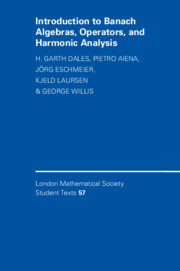Book contents
- Frontmatter
- Contents
- Preface
- Part I Banach algebras
- Part II Harmonic analysis and amenability
- Part III Invariant subspaces
- Part IV Local spectral theory
- 21 Basic notions from operator theory
- 22 Classes of decomposable operators
- 23 Duality theory
- 24 Preservation of spectra and index
- 25 Multipliers on commutative Banach algebras
- Part V Single-valued extension property and Fredholm theory
- Index of symbols
- Subject index
25 - Multipliers on commutative Banach algebras
Published online by Cambridge University Press: 29 December 2009
- Frontmatter
- Contents
- Preface
- Part I Banach algebras
- Part II Harmonic analysis and amenability
- Part III Invariant subspaces
- Part IV Local spectral theory
- 21 Basic notions from operator theory
- 22 Classes of decomposable operators
- 23 Duality theory
- 24 Preservation of spectra and index
- 25 Multipliers on commutative Banach algebras
- Part V Single-valued extension property and Fredholm theory
- Index of symbols
- Subject index
Summary
Multipliers
In this chapter I want to give an impression of what sort of information becomes available via local spectral theory when it is applied to a particular class of operators, namely the multipliers on a commutative Banach algebra. Throughout this chapter, the letter A will denote a commutative, complex Banach algebra.
Definition 25.1.1A linear map T: A → A is a multiplier if aT (b) = T (a)b for all a, b ∈ A. The set of multipliers on A is denoted by M(A).
The most obvious example, given A, is the multiplication operator La induced by a fixed element a ∈ A, that is, the operator La(b):= ab for all b ∈ A. If A has a unit e (A is unital) then every multiplier T is a multiplication operator. In this case (Exercise 25.3.2).
If the map a → La: A → B(A) is injective (faithful), then A is said to be a faithful algebra. Every unital algebra is faithful, as is every semisimple, and also every semiprime algebra – the latter term means, in our commutative case, that the algebra contains no non-zero nilpotent elements.
Example 25.1.2 Let A:= C0(Ω) be the Banach algebra of all continuous complex-valued functions vanishing at ∞ on the locally compact Hausdorff space Ω, and let f ∈ Cb(Ω) be a bounded continuous function on Ω. Then T := Lf (notation self-explanatory by now) is a multiplier. Conversely, it can be shown that a multiplier gives rise to a bounded continuous function on Ω with respect to which the multiplier acts by pointwise multiplication (Exercise 25.3.4).
- Type
- Chapter
- Information
- Publisher: Cambridge University PressPrint publication year: 2003



